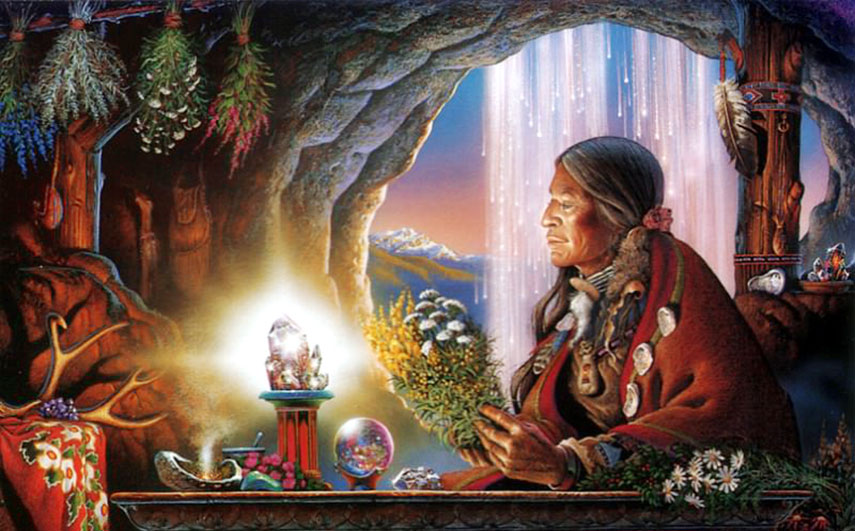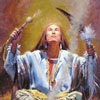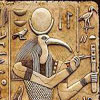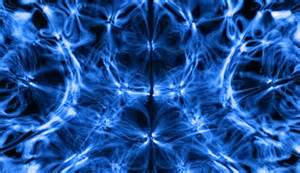Secrets Of The Shamans ~ Part I
 by Vincent H. Gaddis
by Vincent H. Gaddis
During the winter of 1866 a group of Sioux camped in the Powder River country, near Piney Creek in Wyoming. Food was low, and the tribesmen tramped through the deep snow in a desperate attempt to find game. After a disappointing hunt they returned to the camp, but many of them were snow blind, unable to see from having looked too long at the glare of sunlight on the snow.
The blind men were taken to a medicine man who had learned healing through dreams and visions. The shaman placed snow over the eyes of the afflicted men, then he sang a song he said he had learned in a dream. Next, he placed snow in his mouth and blew some of the flakes upon the heads of the men. Immediately their blindness went away. Snow blindness is usually temporary, but severe cases can last a considerable time, and sight returns gradually.
This was healing by ritual and a song.
Luther Standing Bear, who lived on the Oglala Sioux Reservation at Pine Ridge, South Dakota, was an educated man. One day he was alone in his home with his stepmother when she suddenly collapsed. He carried her to a bed where she tossed and moaned in agony. Standing Bear hurried away and brought back the tribal medicine man, White Crow.
For a few minutes the medicine man watched the woman suffering on the bed. Then from his medicine bundle he withdrew a piece of root which he cut in two. He asked the woman to chew both pieces until they were soft. Finally he had her swallow one of the pieces and rubbed the other on her chest. Five minutes or so after she did as instructed, all pain left her body and she got up and resumed her work. White Crow refused to tell Standing Bear the name of the plant from which the root came or to sell him another piece of root. That was a medicine man’s secret.
This was healing by herbs.
Another remarkable cure was witnessed by Dr. J. M. De Wolf, an army surgeon, and Paul Beckwith, an anthropologist. The patient had been hunting some distance from the camp when he was bitten by a poisonous snake. Hours had passed by the time he managed to stagger home. Dr. De Wolf examined the badly swollen leg and said the poison had been working too long for him to be able to help the victim. Death was not far away.
Then the tribal medicine man was brought to the scene. He gave the stricken man a herb to eat and then performed a ceremony, singing a song as he shook his rattle and beat his drum. In a short time the patient was cured, walking around none the worse for his experience.
This was apparent healing by both herbs and ritual.
To an American Indian the meaning of the word medicine is quite different than its connotation among whites. To most native Americans medicine signifies not just treatments and remedies alone, but an array of concepts and ideas about an entire realm beyond his understanding. In most American Indian cultures the medicine man or shaman combines in his person the attributes of many professions. He functions as a priest, philosopher, historian, politician, family counselor, and physician.
Nor can anyone dispute the bedside manners of the medicine men who concentrate on relieving anxiety and improving the morale of their patients, according to Dr. Guenter Risse, of the University of Wisconsin:
This is an area in which the modern physician, engrossed in sophisticated medical technology, has fallen short. When a person becomes ill, he loses his self-assurance and becomes depressed and worried . . . the mere presence of the highly respected shaman is an important morale builder. The shaman represents all of the religious and social beliefs of the tribe and can call on the powerful spirit world. His rituals draw attention to the patient and build up the patient’s hope. White doctors in Navajo reservations have acknowledged the shaman’s power. They say recovery from operations is notably faster if the patient is visited by the medicine man before surgery.
Dr. Robert L. Bergman, a psychiatrist in the Indian Health Service at Window Rock, Arizona, enlisted six Navajo medicine men to teach twelve young tribesmen the elaborate chants that appear to cure Navajo emotional problems. He explained that psychiatrists have come to realize that every culture has brought forth healers of one sort or another who are as effective with their own people as psychiatrists are among Westerners. Cultural expectations appear to play a very important part in the healing process.
There is every indication, Dr. Bergman said, that the twelve trainees will become effective psychotherapists well able to meet the mental health needs of their tribe. Some of the healing chants continue for from five to nine nights in the medicine man’s hogan with the patient’s entire family present.
“It seems to me,” the doctor explained, “that the ceremony is almost always symbolically appropriate to the case. Pathologically prolonged grief reactions, for example, are almost always treated with a ceremony that removes the influence of the dead from the living and turns their attention back to life.”
In Navajo land the medicine men are called “singers.” They work with as many as thirty-five ceremonials, most of them devoted to healing, and each involves word-perfect memorization of numerous prayers and chants. Very few master any large number of ceremonials in their lifetimes, so there is specialization among the singers. In addition, they must learn how to treat wounds, set bones, and have a knowledge of the medicinal properties of local herbs.
Alexander H. and Dorothea C. Leighton, in their book The Navajo Door, tell of the difficult training as follows:
When a man wanted to be a singer, he should start in the summer and get a good crop of corn and harvest it and store itv, and then about the time the first snow flies, build him up a good hogan, and then haul plenty of wood there to do a long time, and have a woman there to cook for him, cook that corn and make bread. Then he gets a singer and has him there in the hogan and they work and keep at it.
If they get too tired, then they can take a sweat bath and next day they feel good and can go on with it again. They stay at it until the first thunder, and then quit. Next summer the learner does the same thing again, and the next winter goes on with the learning. Do that for maybe five years. By that time learn two or three ceremonials.
In other tribes becoming a medicine man is no easy matter. A Blackfoot, for example, undergoes a seven-year training course to qualify as a shaman. The Eskimo shaman learns to name all the parts of his body, including every bone, by its special name in the sacred shaman’s language. In some tribes the schooling includes learning to recite tribal histories and special proverbs. In addition, the prospective medicine man undergoes examination by a group of men already admitted to practice. They review his life and training, his personal characteristics, and his fitness to be entrusted with the exercise of great power.
Medicine man knowledge is the result of many centuries of observation and practice. Long before Sigmund Freud was born, the shamans practiced dream analysis. To the Iroquois, dreams were the windows of the soul through which an individual expressed his unconscious wishes while his body slept. They realized that there is a conscious and subconscious part of the mind, and that subconscious desires, if frustrated, could cause mental and physical illness. They understood the causes of psychosomatic illnesses and how to relieve them by calling up a patient’s hidden thoughts.
This was confirmed by Father Paul LeJeune in the second quarter of the seventeenth century in his study of the shamans of Quebec and Huronia. He and his fellow Jesuits found they had methods of healing the sick which in some cases resembled modern psychoanalysis. In his Relations he wrote that the natives believed one of the main sources of disease “is the mind of the patient himself, which desires something, and will vex the body of the sick man until it possesses the thing required. For they think that there are in every man certain inborn desires, often unknown to themselves, upon which the happiness of individuals depends. For the purpose of ascertaining the desires and innate appetites of this character they summon soothsayers, who, as they think, have a divinely imparted power to look into the inmost recesses of the mind.”
Thus, as Virgil J. Vogel points out in his book American Indian Medicine, whether Indian treatment of disease was less rational than European is debatable. Certainly treatment of external complaints, wherein the origin or nature of the ailment was obvious, was usually rational and often quite effective. However, in cases of persistent internal disorder it was frequently the custom to attribute the disease to a supernatural agency. Especially prevalent among southwestern tribes was the belief in witchcraft as a cause of disease.
The supernatural causes of disease among tribes in general were soul loss, taboo violation, object intrusion, and spirit intrusion. Soul loss occurred when the soul left the body in a dream and began traveling around. Sometimes it was believed the soul had been stolen by enemy shamans or evil spirits. It was the task of the medicine man to bring back the soul through appropriate rituals.
Some diseases were thought to be punishments for taboo violations. These violations included killing an animal without an offering to its spirit, waste of natural resources, and disrespect toward natural elements such as fire by spitting, urinating or throwing offal into the flames. Object intrusion meant that an insect, worm, snake or other small animal had entered the body. Among the Creeks nearly every disease had the name of an animal thought to be its cause [likely symbolically]. It was the medicine man’s duty to remove the object.
As for spirit intrusion it was a belief shared by the people of medieval Europe and colonial America, and “spirit possession” is believed in some quarters. It was supported by numerous biblical references to demon possession. Witches and enchanters, poisonous plants and roots, and human and animal ghosts were thought to be possessed by evil spirits that could cause diseases.
There is an element of truth in all these concepts. In our bodies there are microorganisms (and occasionally worms and teratomas). Spirit possession is debated in psychical research. In our waste of natural resources we are already paying a price and our punishment will be greater in the future. The poison in plants may be called a spirit, but it is still a poison that can kill. Much of what we accept as fact today will be disproved by the sciences of the twenty-first century and beyond. It is belief that make customs and practices work.
It was, however, in the realm of herbs and drugs that the American Indians made their greatest contribution to the healing arts. Dr. Arthur S. Freese, in his book Pain, states that of the 144 known drugs “the North American Indian medicine men used for a variety of conditions, nearly half are still used in our pharmacopoeia.” Even in comparatively recent times, American Indian pharmaceutical practices have helped open new frontiers in medical history. Insulin, cocaine and the use of drugs to control the menstrual cycle (which launched the research that led to “the Pill”) are examples. American Indian gifts to combat illness include arnica, cascara, ipecac, oil of wintergreen, petroleum jelly, quinine and witch hazel. Some plants were brewed into tea for the patient to drink. Other plants were chewed and eaten or applied as poultices or salves on the affected parts of the body.
Joseph Logan, a resident of Ontario’s Ohsweken Indian Reservation, consulted a non-Indian doctor for a routine physical examination some years ago. He was told that X-rays disclosed that he had tubercular spots on his lungs, and he was advised to take a long sanitarium rest. Logan said he would think it over and come back later for another X-ray examination.
Several months later Logan did return to the doctor’s office. To the doctor’s surprise this time there were no spots on the lungs. Today the elderly Logan bears no signs of tuberculosis. He is one of thirty council members in Canada’s Six Nation Indian Confederacy and is a widely respected shaman. In an interview with reporters he said American Indians believe that “Nature provides all cures for all illnesses. God would not put man on earth without such cures.”
An elderly man suffering from cancer of the face was told at the University of Utah Medical School that he would die unless he had radical surgery. He refused and went home to St. George, Utah, to await the end. Several months later he returned to the university, and to the astonishment of the physicians he had made an amazing recovery. According to United Press International, an old American Indian friend, a retired shaman, had advised him to drink cups of “chaparral tea” which is brewed from the leaves of the creosote bush.
University researchers found that the tea contained an ingredient called nordihydro-guaiertic acid or NDGA. Later research at the University of Nevada revealed that NDGA is a potent inhibitor of the mitochondrial functions within animal cells, which is the area where metabolic energy is produced. The acid seems to work only on diseased or cancerous cells. Dr. Dean C. Fletcher, chairman of the department of biochemistry at Nevada, is cautious about its use as a cancer cure and says much more research is needed.
Another contemporary medicine man is Louis Prince of the Salteaux tribe living on the shores of Lake Manitoba. He is a healer, but it is his clairvoyance in locating drowned bodies that has brought him fame. For his healing ceremonies he uses a skin rattle filled with shells, a whistle that is said to emit high sighing sounds during incantations, and a pipe.
A detailed account of how he located one body was reported in the Winnipeg Tribune (26 July 1954). A five-year-old boy, accompanied by two other boys, went down to the swollen Assiniboine River to bring a bucket of water back to his home. The bank caved in, throwing the boy into the water. All his companions could do was run for help. Royal Canadian Mounted Police dragged the river, and tribesmen searched along the banks and from boats.
Bruce Pashe, a native, decided to enlist the assistance of Louis Prince. On the third day he managed to get a ride to Sandy Bay where Prince has his home. Prince met Pashe and his friend with the automobile at the door dressed up and ready to go. “I knew someone would be coming to get me,” he explained. In the car Prince said the search was being made in the wrong location. “The body is down farther, beyond where the white men are building something across the river.” This “something” was a net built by the police in hopes of intercepting the boy’s body as it passed downstream.
The medicine man first went to the victim’s home, then walked alone to the river bank. Returning to the house, he held a séance with five tribesmen and a white farmer friend present. A pipe of tobacco was passed to all the men. Prince spread powder on a plate of hot coals provided by the victim’s father, then called on the gods for help. Those in the room said the whistle lying on the floor whistled throughout the ceremony. Sounds like voices were heard coming from the plate of ashes.
“The body will be found six bends down the river caught in tree boughs,” Prince finally announced. And that’s where the body was found the following morning.
Among some southwestern tribes, especially the Navajo, sandpainting is an ancient art for healing the sick. The medicine man “paints” on the ground or on buckskin or cloth by skillfully permitting sand to flow through his fingers. Instead of sands of various colors, he may use flower pollen, corn meal, powdered roots and bark. The creation of ceremonial sandpainting is a sacred ritual which the American Indians believe places the medicine man in contact with spiritual forces to heal and bless the ill.
According to David Villasenor in his book Tapestries in Sand, the intricate and beautiful sand paintings and the accompanying chanting and rituals have a miraculous effect upon patients. Villasenor is an artist and sculptor who makes sand paintings at American Indian ceremonial meetings and explains their meanings. A part Otomi Indian, he was adopted into the Navajo tribe as a youth and learned from the medicine men not only how to make sand paintings, but their spiritual meanings and the beauty and wisdom of native mysticism that they represent.
Next to the Navajo, the Ojibwa are the second most numerous American Indian group in North America. They and other neighboring Algonquin groups to whom the Ojibwa are related through language and culture have gained a reputation as practitioners of the occult arts. The Ojibway medicine men use a method of healing that is practiced by other cultures, and it appears to be an ancient component of peoples in both the New World and the Old.
Joseph B. Casagrande witnessed this healing séance on the Lac Court Oreilles Reservation in northwestern Wisconsin. He has done field work among the Ojibwa and Comanche tribes and published studies on their languages and ceremonialism. He served as staff secretary at the Twenty-Ninth International Congress of Americanists.
This performance of the sucking doctor or medicine man is the most powerful form of therapy available to the Ojibwa. It is undertaken to cure the victims of sorcery or patients suffering from diseases resistant to other forms of treatment. In the séance Casagrande observed the shaman was John Mink, a nonagenarian and the most respected man on the reservation. The patient was Prosper, a man in his sixties who was nominal Christian but, like so many American Indians, owed allegiance to both Christianity and native tradition. The ceremony was held in the medicine man’s cabin.
First Mink’s assistant and drummer covered the windows to shut out all light and made sure there were no dogs around whose barking would disturb the performance. A candle provided the only light. Prosper was asked to lie on a blanket on the floor. The spectators sat in a semicircle around him, and Mink stood facing them on the other side of the supine patient. The assistant put two finger-length tubes made from the leg bones of a deer into a pie tin half filled with salt water. This tin he placed beside the patient and covered it with a red bandanna.
Mink began the ceremony by telling how he had acquired his powers. During a fast he had a dream. Led by a flock of geese, he came to a hut inhabited by six spirits. Later there came a beautifully dressed lady whose home was in the sky. These were the ones, Mink said, who taught him how to cure people and taught him the songs to sing in summoning their help.
Accompanied by his assistant on the drum, the medicine man began to sing as he shook his rattle, calling in the spirits that were to help him. After singing several songs, he shook the rattle over Prosper and also around his own body. As the drumming continued, Mink placed one of the bone tubes in his mouth, swallowed it as his body jerked and swayed, dropped to his knees beside his patient, and regurgitated the tube. Bending down, he sucked through the tube several times in the region of Prospers abdomen, ending each sucking by blowing through the tube into the pan of salt water. Finally he signaled his assistant to stop the drumming and help him to his feet.
After a brief rest the shaman sang another song, followed by a second series of suckings. This time he extracted a small piece of a whitish substance which was passed around in the pie tin for inspection. Mink announced that he had removed only a part of the disease, but believed he could get the rest of it the following night when he would summon stronger spirits.
The group reassembled the next evening and with only minor variations the ceremony of the previous night was repeated. Prosper stated that he had slept well for the first time in months. Mink asked the two women present to assist him, one to shake his rattle and the other to place the bone tube in his mouth. The reason, he explained, was that two female spirits were helping him this time. He had his assistant get him a larger bone tube. On the first attempt he sucked from the patient’s abdomen a small maggot and several pieces of the same white stuff. He announced that he had now gotten it all.
Casagrande writes, “Despite his great age, John Mink’s performance had force and dramatic quality. Watching the ceremony, I sensed the weight of history that lay behind it—here, I felt, was an expression of the human mind and spirit to which we are all heir.”
Excerpt from American Indian Myths & Mysteries
See Part II here.
Posted in Other Topics, Spirituality, True History of Manwith comments disabled.





